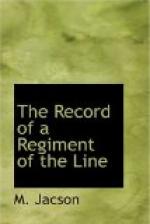This column consisted of the 5th Lancers, 19th Hussars, Natal Carbineers, Border Mounted Rifles, Imperial Light Horse, Devons, Liverpools, Gloucesters, 60th Rifles, and twenty guns, in all about 5500 men.
The enemy was found posted on Tinta Inyoni Mountain, on the summit of which they brought a gun into action and fired on to the head of Sir G. White’s force, which was in column of route on the road, but without doing any damage. The action began at 8.30 a.m.
At the commencement of the action the battalion was in reserve, and was ordered to extend and lie down at the foot of the first slope facing the enemy’s position, and some 300 yards north-west of the railway line, sending scouts to the crest of the ridge to watch the front. Four companies were shortly afterwards ordered to advance in attack formation, forming their own supports, and to place themselves on the left of the Gloucester Regiment, which was in front of the Regiment at the time. The Regiment was then on the extreme left of the firing-line. The four companies of the reserve worked round under cover to a small nullah about 300 yards on the left and then advanced up it. The firing-line advanced, under slight rifle fire, across a rocky plateau till they gained a small ridge overlooking the front, and opened fire by section volleys on to a ridge about 800 yards in front, from which a rather heavy fire was coming.
The Maxim gun under Lieutenant Price-Dent came into action in rear of the left of the line and fired at the enemy to the left front.
The enemy’s fire from this ridge was soon silenced, and from that time the only objective the line had was a few scattered Boers and their horses on the rear slope of the high hill to the left front, some 2000 yards distant.
The reserve was deployed into two lines of double companies on and below a small ridge of rocks some 250 yards in rear of the firing-line. At about 2 p.m. the retirement commenced, and the battalion gradually followed the Liverpool Regiment and became rearguard. Ladysmith was reached about 3.30 p.m., after a sixteen-mile march in torrents of rain.
The casualties of the battalion during the day were:—
1 private killed.[1] 25 privates wounded, none dangerously.
[Footnote 1: This private, the first man of the Regiment killed in the war, was Private Winsor. He was shot dead through the heart by a stray bullet.]
This action was known as the action of Reitfontein.
On October 26th General Yule’s force marched into Ladysmith. They had had a bad time, having marched in drenching rain, day and night, from Sunday till Wednesday. The garrison of Ladysmith gave them food on arrival, the Regiment supplying the Dublin Fusiliers (officers and men) with refreshments.
On October 27th it was reported that the Boers were nearing Ladysmith and attempting to surround the place, and a large force was ordered out by Sir George White to reconnoitre.




